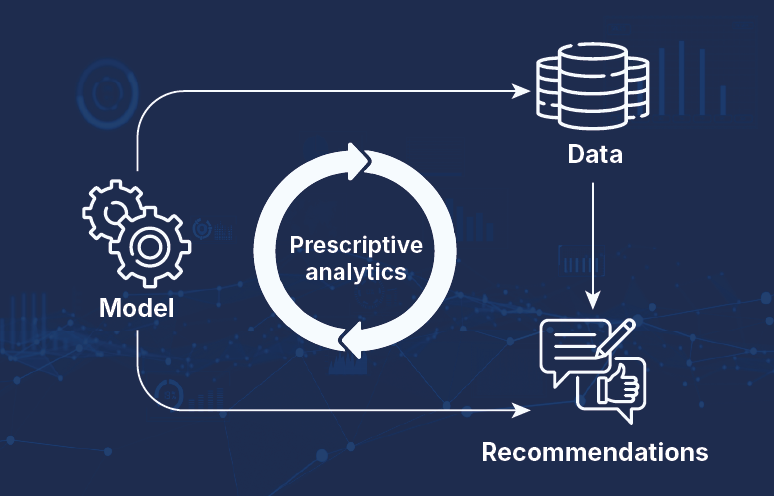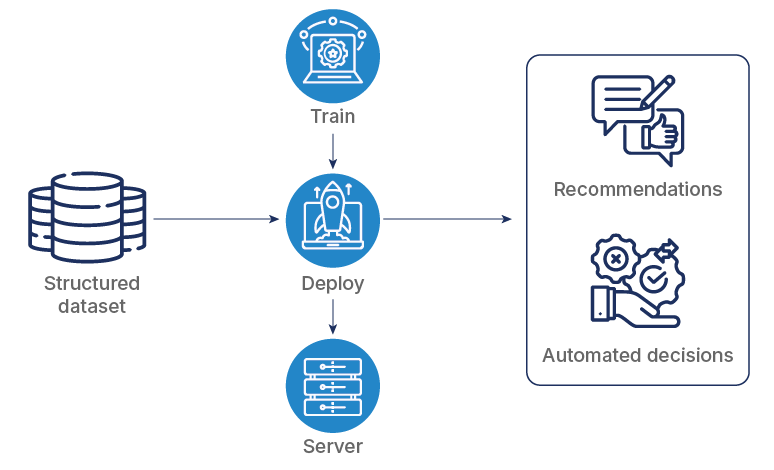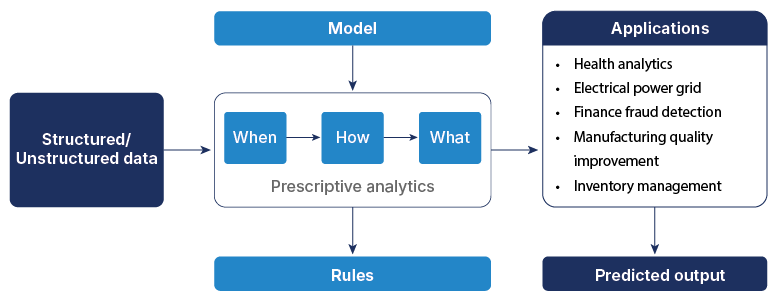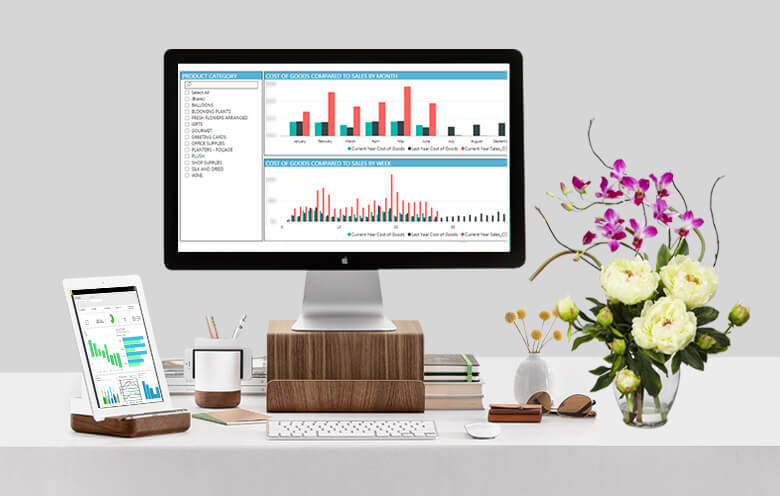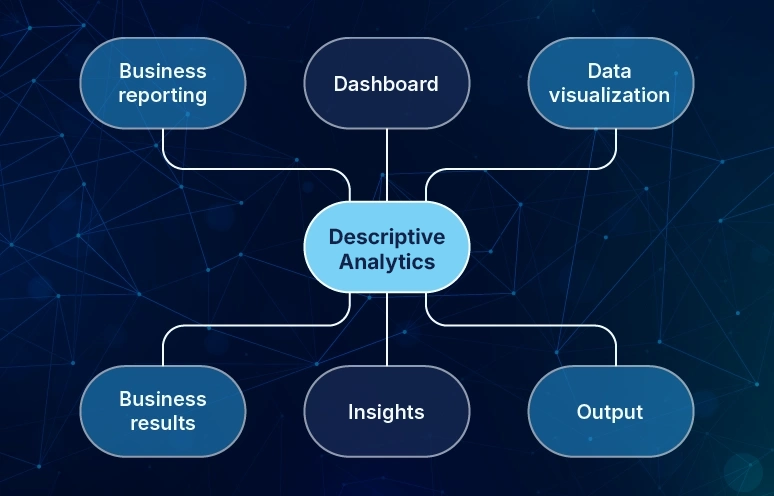Prescriptive analytics analyzes raw data to identify patterns and recommend the best course of action. It is a type of data analytics that helps businesses make better decisions. When used in business, data analytics is called business analytics.
There are four types of data analytics, and prescriptive analytics is the most advanced one:
- Descriptive analytics: answers “What happened?”
- Diagnostic analytics: answers “Why did it happen?”
- Predictive analytics: answers “What might happen next?”
- Prescriptive analytics: answers “What should we do next?”
At its core, prescriptive analytics answers the vital question: What step should be taken to solve a specific problem or achieve a desired outcome? It uses advanced analytics techniques and conducts scenario analysis to drive actionable insights from data.
A Forrester study found that 65% of C-level executives favor prescriptive analytics over predictive analytics for strategic planning.
In this blog post, we will explore what prescriptive analytics is, how it works, benefits, differences between prescriptive analytics and predictive analytics, and examples.
What is prescriptive analytics?
Prescriptive analytics is a statistical method that recommends the strategic move or ideal course of action. It uses advanced processes and tools to analyze raw data, identify patterns and answer questions like, “What should be the next step?”. Prescriptive analytics consider potential situations, resources available, past data, and present performance and recommend a direction or strategy. It is an effective instrument that employs sophisticated technology in assisting companies in making improved choices on any horizon, from instant to long-term.
Machine learning is employed in prescriptive analysis to crunch more data more rapidly and efficiently than humans. Whether churn prediction, risk evaluation, fraud detection or demand prediction, companies apply prescriptive analysis to offer personalized suggestions and improve customer experience.
For example, businesses can apply prescriptive analytics within supply chains. They can determine the most economical route, optimize inventory levels, and minimize transport costs and delivery time.
What are the benefits of prescriptive analytics?
Prescriptive analytics helps you make better decisions by analyzing raw data. From increasing revenue, reducing customer churn, preventing fraud, to increasing efficiency this technology offers data-driven guidance. According to research conducted by McKinsey, prescriptive analytics:
- Increased online sales growth by 30%
- Reduced inventory costs by 15%
- Reduced churn among top-performing employees by 50%
Here are the key benefits in more detail:
-
Revenue generation
Prescriptive analysis helps businesses identify the needs of their customers. It provides the company with customer search results. This allows organizations to efficiently frame marketing campaigns, enhance customer experiences, and increase conversion rates. These data-driven activities ultimately convert into improved sales and long-term revenue growth.
-
Improved decision making
Through optimized algorithms, prescriptive analytics helps businesses make data driven decisions. It recommends businesses take specific actions by analyzing factors like potential future scenarios and historical data. Simulating scenarios and probabilities allows businesses to identify potential risks and rewards prompting them to make informed choices.
-
Enhance resource optimization
It processes complex data to help businesses make the most of their resources. Prescriptive analytics analyzes raw data and suggests strategies to optimize budgets, inventory, employees, and other assets effectively. Therefore, the proactive approach improves revenue, enhances efficiency, and resource utilization.
-
Improve strategic planning
Businesses can examine different scenarios and their impact on operational performance. They can analyze market trends, resource availability, and risks involved. It can help them adjust their strategies to better identify opportunities and challenges.
-
Risk mitigation
Organizations can identify and mitigate potential risks by analyzing scenarios and consequences. Prescriptive analytics identify fraudulent activities, potential threats, and credit risk to minimize potential risks.
How does prescriptive analytics work?
Prescriptive analytics workflow uses advanced analytics techniques that recommend you take the next step instead of showing what happened in the past or what will happen in future. Let’s have a look at how prescriptive analytics work, but the output will depend upon your specific use case and the AI development service used.
-
Define the question
Start by identifying the problem you would like to solve or the question you would like to get the answer. You would need data to train the model to provide an answer. Collect real-time data, historical and external information to help your AI model produce accurate results.
-
Develop model
Once the data is collected, you need to develop prescriptive models. You can use an AutoML tool to develop customized ML models in-house, or you can hire an AI development service provider to code models from scratch. The model can require structured and unstructured data and business rules to be followed in the development process. It may apply techniques like optimization, graph analysis, heuristics, simulation, or game theory. You will need to fine-tune the model through multiple iterations and test it using new data to ensure it provides the most accurate output.
-
Model deployment
Once the model starts performing optimally, you can integrate your model into other applications so that your team can efficiently use it. If you are creating the model for a one-time project, asynchronous batch recommendation works best. If the prescriptive model is prepared for an ongoing process where another application depends on quick prediction, here a synchronous, real-time deployment works best. Your custom-designed ML model should adapt as new data comes in, improving output accuracy.
-
Mapping outputs to outcomes
After successful deployment, map the output to the recommended outcome. Implement actionable insights from data produced as output and compare them to business goals such as enhanced customer experience and cost saving. This allows decision makers to understand the impact of the recommendation provided by the model. By comparing the recommendations to the outcomes, businesses can clearly understand the effectiveness of their decisions.
-
Ongoing support
Once the models start generating recommendations, verify if it provides output as per your business requirement and take appropriate action. The performance of the model should be monitored continuously based on the changing environment and feedback received to ensure the output aligns with business needs. Some situations might require the use of human judgment and intuition thus a prescriptive model is used to enhance the decision making process.
What is the difference between prescriptive analytics and predictive analytics?
When comparing various forms of data analytics, it is simple to be confused between predictive analytics and prescriptive analytics. Although both rely on data to inform decisions, their objectives and endpoints vary. Knowing the distinction will enable companies to select the appropriate data analytics services that meet their individual needs.
| Aspect | Predictive analytics | Prescriptive analytics |
|---|---|---|
| Purpose | Forecasts what is likely to happen in the future | Recommends actions to achieve the best possible outcome |
| Key question | “What is likely to happen?” | “What should we do about it?” |
| Techniques used | Statistical modeling, machine learning, and forecasting | Optimization, simulation, heuristics, and decision analysis |
| Outcome | Provides insights into possible future scenarios | Suggest specific actions and their potential impact |
| User focus | Helps understand trends and prepare for changes | Helps choose the best path and make data-driven decisions |
| Complexity | Relatively simpler models focused on predictions | More complex, action-oriented models with constraints |
What are the examples of prescriptive analytics in business?
Prescriptive analytics provides actionable recommendations to optimize strategies and the decision-making process across industries. In this section, we’ll explore how different industries are using prescriptive analytics to solve real-world challenges and deliver better outcomes.
-
Healthcare management
Prescriptive analytics assess quality risk in the medical sector by identifying a variation in practice. It improves operational efficiency through bed management, staff scheduling, and resource allocation. Healthcare providers can promote wellness and the management of diseases more effectively. For instance, it identifies the best method for specific kinds of treatment. It provides recommendations that the patient might require knee replacement surgery instead of a repair procedure.
-
Financial risk management
Detects and flags financial fraud by conducting comprehensive risk assessment and mitigation in the financial sector. The algorithm analyzes patterns in transactional data, triggers an alert, and recommends a step to be taken. For instance, a company spends around $30,000 per month as payment for a supplier, suddenly a $2 million transaction is recorded. Here the prescriptive analytics model triggers an alert by identifying unusual spending patterns, and reports to the finance team. It recommends immediately acting for payment verification, to prevent fraud or errors.
-
Energy and utilities
Prescriptive analytics has the capability of streamlining the distribution and utilization of resources in the energy and utilities industry. It anticipates demand, enhances the upkeep of infrastructure, and minimizes costs. For example, Shell uses prescriptive analytics in its energy production and distribution processes. By forecasts market demand and prescriptive analytics recommends optimal production schedules and maintenance plans. Thus, reducing unplanned downtime, improving safety, and resource allocation for higher operational efficiency.
-
Manufacturing
After the AI model has forecast equipment breakdowns, prescriptive analytics suggest measures that can optimize production efficiency and quality control. This proactive approach improves resource planning. It enhances maintenance planning and reduces waste management. Thus, leading to huge cost savings and increased efficiency. For example: Siemens uses prescriptive analytics to collect data from sensors and identify optimal production schedules and material allocation. This approach reduces equipment failures and improves production efficiency. Thus, Siemens can respond quickly to market demand fluctuations.
-
Supply chain management
Prescriptive analytics streamlines inventory management, distribution planning, and demand forecasting within supply chain management. With effective resource allocation, prescriptive analytics enables organizations to lower operational expenses. For example, it informs the supply chain manager where and when the product is needed.
Drive strategic action from data with prescriptive analytics
Prescriptive analytics integrates data, AI, and automation into the decision-making processes. It provides actionable recommendations in real time. And as companies scale, technology becomes essential to manage complex processes. Prescriptive analytics responds to shifting market landscapes, and fuels innovation in every function. With advanced algorithms and powerful computing, prescriptive analytics will become ever more accurate. It enables organizations to predict problems and respond with confidence ahead of time. It is time to invest in prescriptive analytics to create future-proof strategies and streamline operations. Prescriptive analytics offers a winning advantage in a dynamic world.
